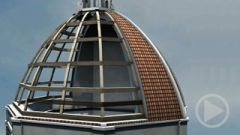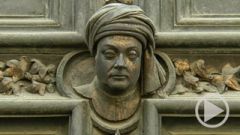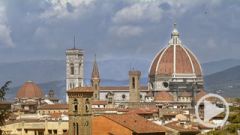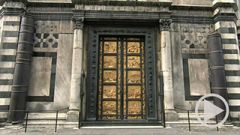- Home
- »
- Welcome
- »
- Italy
- »
- Florence
- »
- Florence Cathedral
- »
- Florence Cathedral - Filippo Brunelleschi
Filippo Brunelleschi
Filippo Brunelleschi:
Genius, Failure, and Ultimate Triumph
In February 1426, the cathedral dome is 17 metres high. Now the walls tilt to such an extent that the bricks are sliding inwards. It must be a fearful sight for the masons as they look down – without their usual scaffold to support them. All they can do is have faith in Filippo’s ingenuity. The wool magnates are confident, and a committee still sees no need to erect a centering. And Filippo rewards their trust with a stroke of genius.
He has the walls erected in a herringbone pattern. It’s a familiar technique: bricks are laid horizontally, then at intervals of just under a meter, one brick is placed vertically. The Romans built this way long ago. But Filippo recognised the fact that because the walls are slanted, a kind of mini-vault forms between the vertical stones. This means that the last brick in every layer has the effect of an apex stone – and layer for layer a stable, self-supporting construction is created. Using an ancient construction technique to build an impossible dome – that’s Filippo’s ingenious idea.

The approach has yet another advantage: even the vaults themselves no longer require an apex stone. This means the top of the dome can remain open – and light falls into the church through the ‘oculus’.
But not everything goes swimmingly for the great Filippo. There is, for example, his plan to revolutionise marble supply. The white slabs come from the quarries of Carrara, and transporting them is incredibly expensive: they are shipped to Pisa and from there, dragged up the Arno to Florence. But the river is barely navigable, and sometimes marble is in such short supply that the cathedral authority requisitions reserves for gravestones. Filippo scents a good business opportunity and pledges to cut the shipping costs by half. He constructs a monstrous amphibious vehicle, a barge and low-loader rolled into one. He receives the first ever patent for the design. But the venture turns out to be a huge flop: the monster barge runs aground on the sandbanks of the Arno on its maiden voyage. Tonnes of precious marble are lost – taking a third of Filippo’s fortune down with them.
Things go wrong for him again ten years later. During the Florentine siege of the neighbouring city of Lucca, Filippo devises a cunning plan: he suggests digging a trench and simply flooding the city. But the idea is a total disaster. Filippo manages to inundate the Florentine camp as well. The Florentines are forced to make a hurried retreat – and Filippo is never again awarded a military contract.
But this does nothing to curtail his fame. His magnum opus is finished at last. On March 25th 1436, Pope Eugenius the Fourth dedicates the new cathedral Santa Maria del Fiore. Little Pippo Brunelleschi, who had once played in the shadows of the brick walls, has achieved the impossible.

There is yet another competition for him to enter. The crowning feature of the cupola is still missing: the lantern. This time Filippo easily wins the contract. It’s clear to the Opera del Duomo that the lantern is an important element of the dome’s structural design. It can’t be too heavy – but on the other hand it must be heavy enough to provide additional stability to the vault.
Construction of the lantern begins in 1445, using Carrara marble and increasing the height of the dome by 20 metres. It will eventually be completed by Brunelleschi’s successor – the same Antonio Manetti to whom we owe the first biography of Filippo. In the year after work on the lantern began, Filippo dies suddenly, not even 70 years old. The entire city of Florence mourns his passing.
Filippo Brunelleschi was the first architect in history to be revered as a great artist during his lifetime – and the first never to have received instruction at a mason’s lodge. Not adhering to traditional techniques, but relying on his own inventions and instincts – fully aware of his own genius and always looking to build on his reputation: all this has nothing more to do with the total piety of the Middle Ages. Brunelleschi was the first modern architect. And he still holds one record to this day: he has created the largest masonry dome of all time. The dome of the Capitol building in Washington is almost a third smaller.
Filippo is of course buried inside his cathedral – but his grave is forgotten. It is only rediscovered during excavations in 1972.






